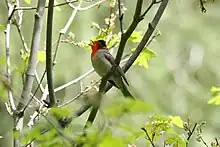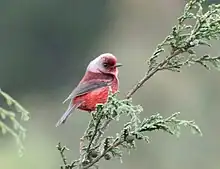| Cardellina | |
|---|---|
 | |
| Red-faced warbler (Cardellina rubifrons) | |
| Scientific classification | |
| Domain: | Eukaryota |
| Kingdom: | Animalia |
| Phylum: | Chordata |
| Class: | Aves |
| Order: | Passeriformes |
| Family: | Parulidae |
| Genus: | Cardellina Du Bus de Gisignies, 1849 |
| Type species | |
| Cardinella amicta[1] = Muscicapa rubrifrons Du Bus | |
| Species | |
|
See text | |
Cardellina is a genus of passerine birds in the New World warbler family Parulidae. The genus name Cardellina is a diminutive of the Italian dialect word Cardella for the European goldfinch.[2]
The genus was introduced by the French naturalist Charles Lucien Bonaparte in 1850.[3] The type species was subsequently designated as the red-faced warbler.[4][5] The genus originally contained one species, the red-faced warbler. A comprehensive study of the wood-warblers published in 2010 that analysed mitochondrial and nuclear DNA sequences found that the five species formed a discrete clade, with the Wilson's and Canada warblers as early offshoots, followed by a lineage that gave rise to two branches - one leading to the red-faced and another that diverged to the red and pink-headed warblers.[6]
List of species
The following five species are currently recognized.[7]
| Image | Scientific name | Common Name | Distribution |
|---|---|---|---|
 | Cardellina canadensis | Canada warbler | Summers in Canada and northeastern United States and winters in northern South America. |
 | Cardellina pusilla | Wilson's warbler | Across Canada and south through the western United States, and winters from Mexico south through much of Central America. |
.jpg.webp) | Cardellina rubrifrons | Red-faced warbler | Mexico and the US states of Arizona and New Mexico, and the Central American nations of El Salvador, Guatemala, and Honduras. |
.jpg.webp) | Cardellina rubra | Red warbler | Highlands of Mexico, north of the Isthmus of Tehuantepec. |
 | Cardellina versicolor | Pink-headed warbler | Southwestern Highlands of Guatemala and the central and southeastern Highlands of the Mexican state of Chiapas. |
References
- ↑ "Parulidae". aviansystematics.org. The Trust for Avian Systematics. Retrieved 2023-07-16.
- ↑ Jobling, James A. (2010). The Helm Dictionary of Scientific Bird Names. London, United Kingdom: Christopher Helm. p. 91. ISBN 978-1-4081-2501-4.
- ↑ Bonaparte, Charles Lucien (1850). Conspectus generum avium (in Latin). Vol. 1. Lugduni Batavorum [Leiden]: E.J. Brill. p. 312.
- ↑ Paynter, Raymond A. Jr, ed. (1968). Check-list of birds of the world. Vol. 14. Cambridge, Massachusetts: Museum of Comparative Zoology. p. 51.
- ↑ Dickinson, E.C.; Christidis, L., eds. (2014). The Howard & Moore Complete Checklist of the Birds of the World. Vol. 2: Passerines (4th ed.). Eastbourne, UK: Aves Press. p. 368. ISBN 978-0-9568611-2-2.
- ↑ Lovette, Irby J.; Pérez-Emán, Jorge L.; Sullivan, John P.; Banks, Richard C.; Fiorentino, Isabella; Córdoba-Córdoba, Sergio; Echeverry-Galvis, María; Barker, F. Keith; Burns, Kevin J.; Klicka, John; Lanyon, Scott M.; Bermingham, Eldredge (2010). "A comprehensive multilocus phylogeny for the wood-warblers and a revised classification of the Parulidae (Aves )" (PDF). Molecular Phylogenetics and Evolution. 57 (2): 753–770. doi:10.1016/j.ympev.2010.07.018. PMID 20696258. Archived from the original (PDF) on 2017-08-10. Retrieved 2018-04-25.
- ↑ Gill, Frank; Donsker, David, eds. (2018). "New World warblers, mitrospingid tanagers". World Bird List Version 8.1. International Ornithologists' Union. Retrieved 1 May 2018.